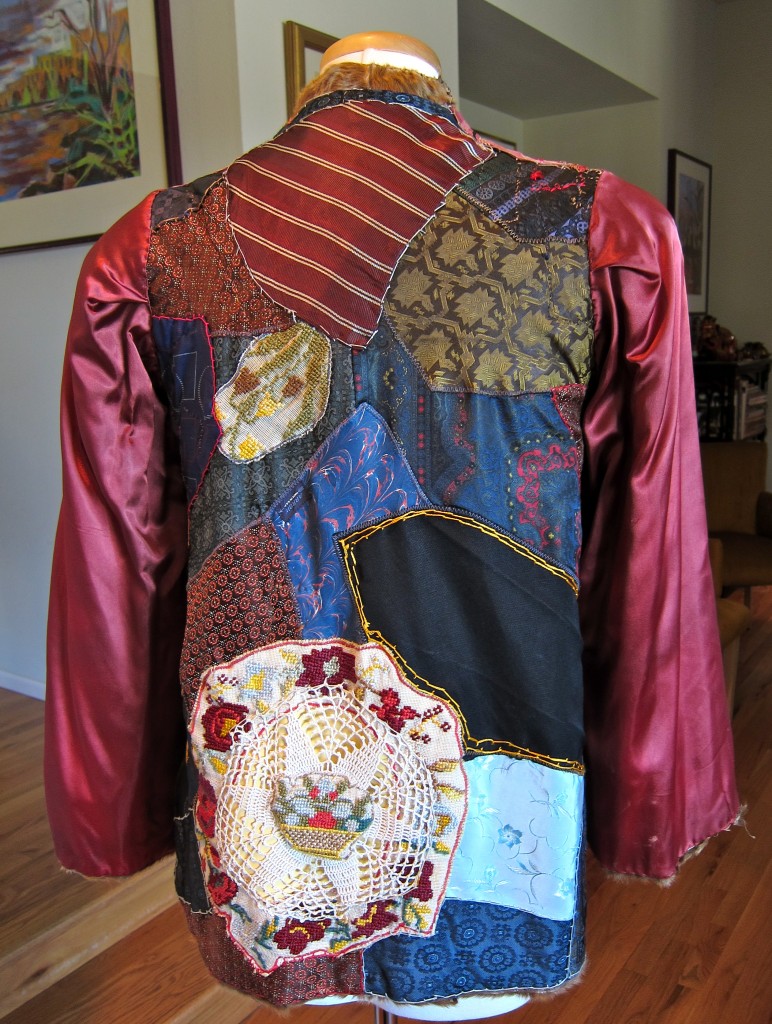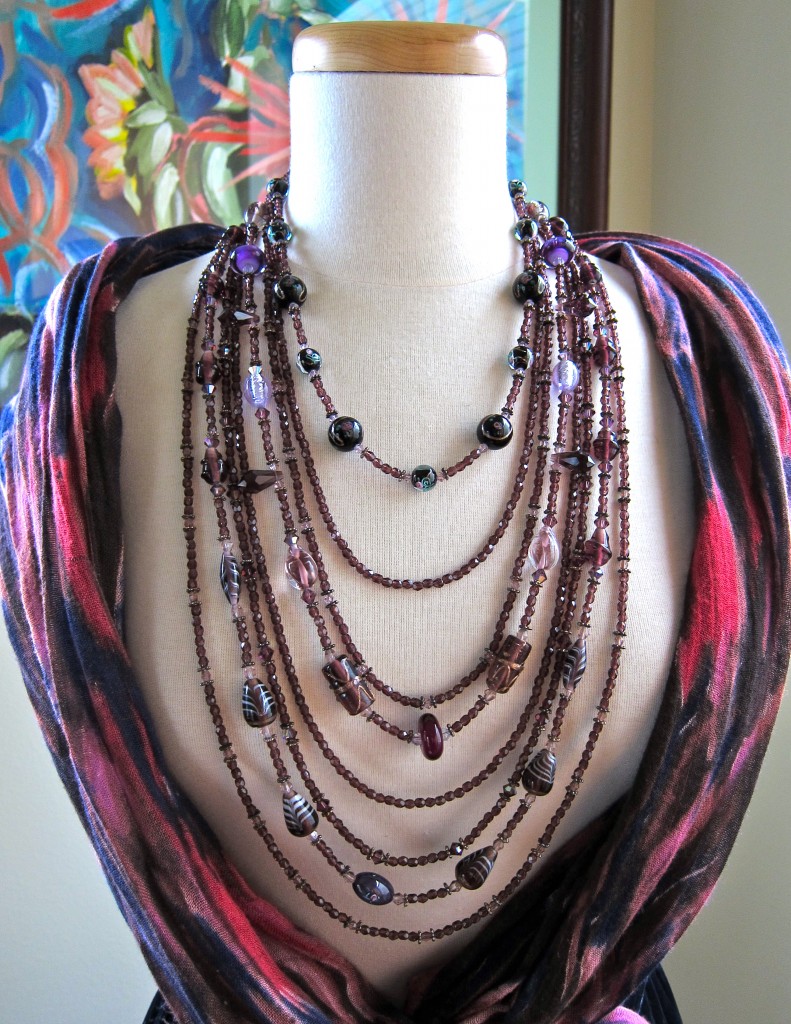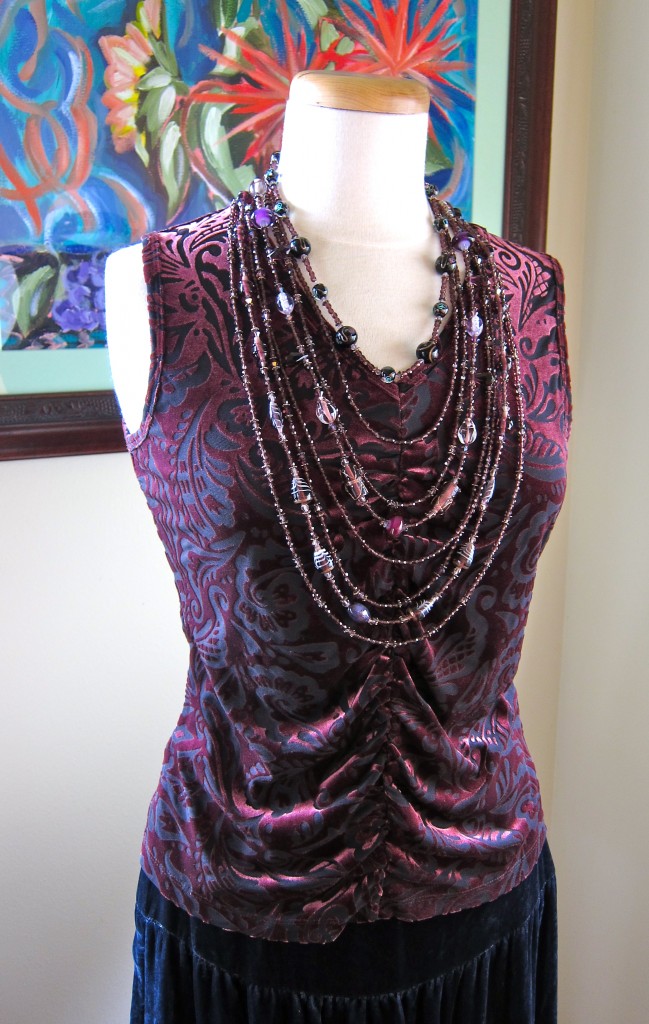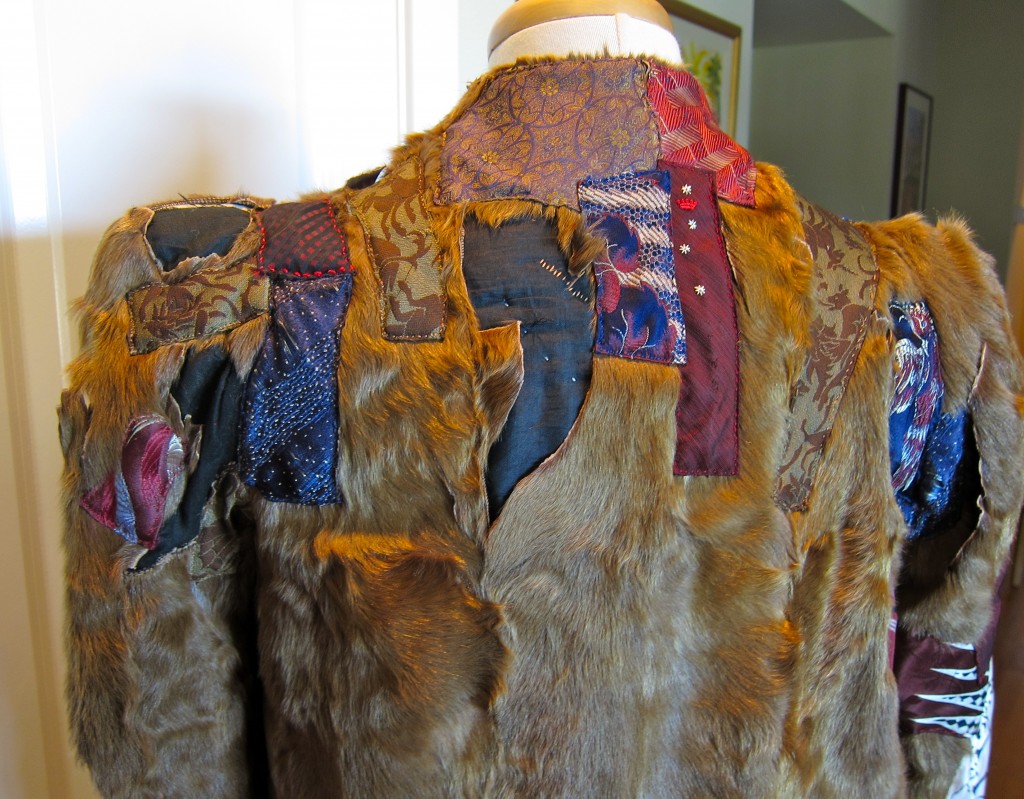
The Ode to Janis Joplin Jacket Inside Worn Outside is a Customized Vintage Fur Coat Made For Janis Joplin

The Ode to Janis Joplin Jacket ~ a Customized Vintage Fur Coat, Eight Strand Ode to Janis Joplin Love Bead Necklace, and The Styled for Janis Joplin Vintage 1930's Persian Lamb and Fur Felt Hat.
I recently posted photos of this Fantastic Ode to Janis Joplin Jacket in my first post about her contribution to fashion The Fantastic Ode to Janis Joplin Jacket ~ One Way to Use Vintage Ties and Furs.

The Back of The Ode to Janis Joplin Jacket Inside Worn Outside
Today I am showing the rest of the opulent characteristic of Janis Joplin Ensemble and The Janis Joplin Accessories that go with it.

The Front of the Ode to Janis Joplin Jacket with the Fur Side Out
Janis loved beads and piled on many strands at once. She was even photographed for Rolling Stone wearing only her necklaces and joked that you couldn’t tell she was nude because she was covered with beads.

The Magnificent Ode to Janis Joplin Necklace
Here is the beautiful eight strand Ode to Janis Joplin Bead Necklace of silver, marcasite, garnets, Swarovsky crystals, rubies, and antique and contemporary glass artist lamp work beads. The ornate clasp is antique silver studded with marcasites.

The Antique Silver & Marcasite Clasp on the Ode to Janis Joplin Necklace

The Ode to Janis Joplin Necklace Over a Wine Silk Burnout Velvet Blouse & Midnight Blue Velvet Tiered Gypsy Style Skirt
The necklace is worn over a wine burnout silk velvet blouse with a dark blue velvet bohemian style three tiered gypsy skirt.

The Crazy Quilted Inside of The Ode to Janis Joplin Jacket is Made of Many Kinds of Beautiful Antique Fabrics and Pieces of Needlework Which Make It a Unique Piece of Bohemian Style Handmade Textile Art.
Janis loved opulent fabrics in deep rich colors.

Legendary Ode to Janis Joplin Antique Black Leather Boots
Janis also loved collected and wore antique boots.

Ode to Janis Joplin Real Victorian Brown Leather Boots
Here is a brown pair of real Victorian Boot Janis Joplin loved and a black pair.
Janis was notoriously quoted in ” FASHION NEWS: I went out & bought myself a $35 pair of boots. Oh they are so groovey!! They’re old-fashioned in their style-tight w/buttons up the front. Black. FANTASTIC! When I get back, I’m going to rent a sewing machine & make myself some sort of beautiful/outlandish dress to go w/them. ”
– Janis Joplin, September 1966

The Ode to Janis Joplin Jacket & The One of a Kind Eight Strand Ode to Janis Joplin Bead Necklace Worn with A Characteristic Janis Joplin Style Ensemble of a Wine Burnout Velvet Blouse and a Midnight Blue Velvet Skirt is Opulent and Amazing!
Here ~ in the gorgeous exotic fabrics Janis Joplin loved ~ is the Ode to Janis Joplin Jacket with the full ensemble of vintage midnight blue velvet three tiered gypsy skirt, vintage wine burnout velvet blouse, custom made one of a kind eight strand Ode to Janice Joplin Necklace of love beads, real Victorian boots and two men’s silk ties worn overlapping each other as a neck scarf. Her fans loved her homemade dresses, skirts and bell bottom pants, and piles of jewelry. And, of course, her customized vintage real fur jackets and hats.

Ode to Janis Joplin Vintage 1930's New Orleans Hat Trimmed in Persian Lamb and Custom Decorated for Janis with Burgundy Ostrich Feathers and A Jeweled Antique Brooch
To top off her outfits Janis often wore vintage fur or felt hats. This Ode to Janis Joplin Hat is originally from New Orleans and is trimmed in curly black Persian lamb fur and decorated with a fantastic jeweled antique brooch, and ostrich feathers! It was picked up at a thrift shop on a jazz festival tour of New Orleans and further embellished with her trademark curling ostrich feathers dyed a rich pink red and a gigantic jeweled brooch. Like everything she owned it is personalized and one of a kind. Janis loved to add colorful ostrich feathers in this form or in elaborate feather boas pinned into her hair.
Janis Joplin sewed! And she shopped in thrift stores. She sought out fabrics, notions and vintage clothes that inspired her. She put things together in her own way. Because she was on stage she inspired the people who saw her live in the 1960s to do the same thing for themselves in their own way. Everything was individually done in this way of dressing and one of a kind, This look was very personal. You had to create much of it yourself from found objects so how you combined things became highly personal. You could not go out to a mall and successfully create such a look. Janis Joplin made and designed many of her own costumes. She also worked with a designer friend to help execute her ideas as she became more successful. She always dressed as a performer ~ simply because she liked to ~ both on and off stage. For her life was really a continual performance. And she dressed accordingly. To her clothing was another form of her artistic expression and she derived great joy in expressing herself this way.
Her fans loved her style. Her influence on the way people dressed in the 60s effected the entire world. She became one of the 100 most influential people in fashion of all time. Because of the way she herself dressed and how much people liked that. Other people wanted to express themselves and their own individuality in a similar way. How she dressed epitomized freedom of choice and self expression and inspired the rest of the world to do the same. No one copied her exactly. That was not the point of her influence. The main point she got across to other people was it is a good thing to be yourself and dress in your own way.
She collected fabrics. She loved exotic materials such as silks, velvets, brocades and metallic jerseys. She wore luxurious leathers, furs, and many beads and jewels.~ particularly armloads of bracelets and many rings on every fingers all at the same time. She wore fluffy colorfully dyed ostrich feather boas in her free flowing long naturally wavy hair. The custom made Ode to Janis Joplin Jacket is hand sewn and skillfully embroidery stitched with many of these types of collected fabrics, including ribbons, hand crocheted lace doilies, embroidered birds and flowers and thrifted Italian silks taken from vintage men’s neckties. People loved Janis Joplin for her music and for her fashion sense. And most of all for her sense of freedom of self.
Janis Joplin’s self made image and often home made style and fashion choices perfectly symbolized what was going on in the world and society at the time. She became the bohemian fashion queen of the hippie movement. She had been ridiculed as unattractive and ugly during her high school years and it must have been tremendously empowering for her ~ in a good way ~ to be admired and respected for her artistic taste and fashion sense! She would probably be amazed to know what long lasting effect she has had on fashion today. Janis Joplin was also innocent and pure in her fashion choices because they came from her heart and soul in the same way her music did. It was improvised spontaneously in the same way she interpreted her songs. Janis always put her own unique twist on things! Her fashions were in no way commercial or mass produced. Her lovely clothes were lovingly chosen and made either by herself or by other artists. She spearheaded a movement to dress the way you wanted to that swept across the world. In her way she was the ultimate dress reformist. And she accomplished this as a side line to her music and unintentionally. She became tremendously influential in fashion just by doing her own thing.

Slashed Fur Sleeves Patched With Silk From Vintage Italian Designer Neckties.
“Do Your Own Thing” incidentally became a catch phrase of the times! And the basic theme and message of many songs and stage musicals like Hair, and Do Your Own Thing, and OH! Calcutta. I think Janis would have loved that! Janis Joplin’s style was not commercially created by stylists and promotion experts. She did not have a huge clothing budget or makeup artists and hair stylists following her around at all times. She did not get done up with hours and hours of preparation for interviews and personal appearances. She refused to wear makeup because she hated the way it looked and felt and she allowed her hair to naturally do its own thing – which meant grow and be wavy and simply put some scarves or feather boas in it to add color and volume.
I think she got dressed like some 3 – 5 year old girls do! They have a closet full of clothes and a costume box and left to their own devices put on and mix up colors and styles wearing whatever appeals to them with no care for what others think every time they get dressed. They often look great in a mix of colors and accessories worn in unconventional ways. It is all done quite spontaneously and I hear grown ups say, “Wow! That looks great! I wish we could wear those things and those colors and fabrics together!” And the mother of the child says, “I don’t choose her clothes or accessories. she does it all herself!” I, personally believe that Janis Joplin got dressed in this same way. And, as she made more money and could afford to buy what she wanted she became all the more colorful and free and self expressive in her clothing choices.
These were simple natural choices for her that were fun and lighthearted and easy for her to accomplish. She had a tremendous natural ease and vulnerability and that was very appealing. It came through in her singing and dancing of course, but it was also how she looked. It amazes me to consider this in contrast to the singers of today – such as Lady Gaga, Boyonce, Gwen Stefani, Rhianna, Madonna and many others who have such commercialized, highly manufactured, expensive to produce and high maintenance personal and stage styles. Janis had none of this “Professional Help.” It is important to realize that she was completely responsible for creating her look herself. I find it hard to see the person under the modern stars styling whereas Janis Joplin was personally completely exposed at all times.

In The Ode to Janis Joplin Jacket- Slashed Furs Reveal Black Cloth Sections of Inner Darkness Beneath the Outer Layers. Rich Deep Colors of Soft Silk Like the Depths of Janis Joplin's Voice and Amazingly Warm and Beautiful Yet Damaged and Vulnerable Furs Enable the Artist to Wear Her Soul On Her Sleeves.
Janice Joplin sang as if she cut herself open and showed us the very insides of her own self and soul in her music in every performance she did. This was the essence of her style and way of dressing as well. Thus, in the Ode to Janis Joplin Jacket the slashed skin sleeves and torn furs revealing sky colored satin embellished with birds embroidered in psychedelic colors of thread perched next to dark rich silks and patches of exotic brocade that symbolize the person and artist Janis Joplin was to those who saw her in the clothing. There are some important patches of personal darkness too in exposed inner sections of black fabric that are open to view under the the torn away outer sections of the amazingly warm and beautiful, yet vulnerable and damaged fur. The Ode to Janis Joplin Jacket is really just like she was ~ original, unusual, delicate, beautiful but rough and exquisite and raw and different all at the same time.
It is important to note that Janis had no aversion to wearing real furs or leather and openly did both. She also loved animals and most notoriously owned a beautiful and affectionate sheep dog. Janis loved her dog. And other furry animals. As far as I know she only wore vintage furs made from pelts of animals killed long before that she rescued from thrift shops. I think she felt, as I do, that rescuing an old fur and giving it new life by wearing it or making it into a beautiful new article of clothing was a way of honoring the already long dead animal from whom it came.

Two Beautiful Men;s Vintage Silk Ties Are Overlapped and Used as a Woman's Scarf Encircling the Lapels of the Ode to Janis Joplin Jacket. The Navy Paisley Tie ifs Vintage Liberty of London and The Wine Colored Floral is Vintage From the Metropolitan Museum of Art Collection.
In Janis Joplin’s characteristically creative personal way of repurposing materials she loved beautiful thrifted silk men’s ties – a vintage navy blue paisley patterned one from Liberty of London and a vintage burgundy floral one from the Metropolitan Museum of Art Collection are overlapped and used as a woman’s scarf to frame the neckline lapels on the fur side of the Ode to Janis Joplin Jacket. This “scarf of ties” treatment works in nicely with the crazy quilting of velvets, brocades, lace, ribbons, embroidery and antique silks used in the jacket. some of the silk patches in the jacket came from old neckties as well.
Janice influenced other people to do their own thing and express themselves through their clothes as much as she did. Many people, especially in the 1960s and 70s did so really well. Because, like she did, they “got down! ” They got down and dressed themselves with things they found and made and put together in their own way.They created their own version of an artistic and eclectic look. And this really worked. People were very often beautifully and very individually dressed in that time. It was a very experimental period. People wore things they really loved with boldness and confidence. It was wonderful to see the things they came up with.
Ever since she came on the scene she has been copied commercially. The mass market has tried to benefit from her style and vision by mass producing cheap imitation versions of her look. They usually look like chap imitations too! It is not exactly a mass produced look! To achieve it and pull off something with a similar success you have to get to the soul of the matter of self dressing. You can do it inexpensively or using expensive fabrics and jewels. You can do anything as long as it is honest and original, preferably self made, found or artist made. It is best done by artists that are your friends or do work that is meaningful to you personally.
You will not be able to go to a mall and assemble pieces to give you such a look. If you do that, or follow the conservative commercial version of “Getting The Janis Joplin Look” as advised in a teen or adult woman’s fashion magazines and certain advice online your attempt to achieve the real Janis Joplin Look will fail completely! I have seen some ridiculous articles and advice columns in magazines and online with utterly tepid versions of the look. You cannot be conservative about this. You have to be absolutely fearless as Janis was. She actually often used very fine luxurious fabrics, furs, beads and jewelry and had a passion for beautiful old high quality boots. She found many of her beautiful fabrics and clothes antique and second hand and this can still be done. As an artist Janis gave old things a new life in her assemblages. Her clothes and outfits were actually artistic collages of wearable items and they became art with her interpretation. Again and again and again her fashion interpretations were like her musical interpretations ~ original and unique with a very personal twist. That is the secret to achieving her look. If you can do that for yourself you will be able to achieve a truly Janis Joplin inspired personal look.
All the Ode to Janis Joplin Clothing and Accessories pictured are from Lady Violette de Courcy’s personal collection, The Lady Violette de Courcy Vintage Clothing Collection. She is a writer, art and vintage clothing collector and fashion historian.
Photos for this article are by Violette de Courcy





















